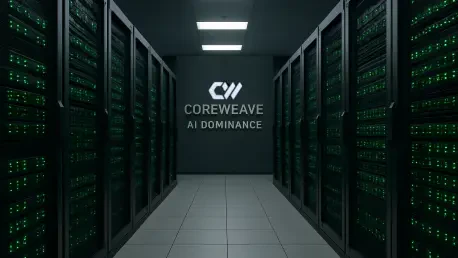In the rapidly evolving landscape of artificial intelligence, Nvidia Corp. stands as a towering figure, not just as a leading supplier of graphics processing units (GPUs) essential for AI model training, but also as a strategic investor shaping the future of the industry. A striking example of this dual role is Nvidia’s substantial $900 million stake in CoreWeave Inc., a cloud computing startup that rents out Nvidia’s high-performance GPUs to meet the surging demand for AI infrastructure. This investment, made as of March, is more than a financial play; it represents a calculated move to solidify Nvidia’s grip on the AI ecosystem. By aligning with a fast-growing partner like CoreWeave, Nvidia ensures a steady demand for its chips while positioning itself to reap significant equity gains. This partnership highlights a broader trend of tech giants leveraging strategic alliances to navigate the competitive and resource-intensive world of AI development, setting the stage for a deeper exploration of its implications.
Strategic Synergy in the AI Ecosystem
The relationship between Nvidia and CoreWeave exemplifies a powerful synergy that benefits both entities in the AI-driven market. Since an initial investment of $100 million in 2023, CoreWeave has seen meteoric growth, with revenue projections climbing to $5 billion by next year, a staggering leap from just $30 million a few years prior. This expansion is fueled by partnerships with major players like Microsoft and OpenAI, who rely on CoreWeave’s cloud platform to scale AI projects without the heavy costs of building proprietary data centers. A pivotal element of this collaboration is the “take-or-pay” arrangement tied to a $6.3 billion order for Nvidia hardware, which commits Nvidia to purchase any unsold cloud capacity through 2032. Such an agreement not only secures revenue stability for CoreWeave but also guarantees consistent utilization of Nvidia’s GPUs, creating a self-reinforcing cycle of hardware sales and potential financial upside through CoreWeave’s soaring valuation, now pegged at an impressive $75 billion.
Beyond the immediate financial mechanics, this partnership underscores Nvidia’s broader strategy to embed itself within the AI supply chain. CoreWeave’s ability to offer GPU workloads at costs 20-50% lower than traditional cloud giants like AWS or Azure gives it a competitive edge, further amplified by early access to Nvidia’s cutting-edge technology. This cost efficiency has attracted massive contracts, including a $6.5 billion deal with OpenAI and a backlog exceeding $25 billion, with over 60% linked to Microsoft. For Nvidia, these developments translate into indirect benefits as the primary GPU supplier, ensuring sustained demand amid a fiercely competitive landscape. Analysts suggest that such alliances could bolster Nvidia’s profit margins by aligning with partners driving ambitious AI initiatives, like OpenAI’s rumored “Stargate” project, which demands compute power on an unprecedented scale. This strategic positioning illustrates how Nvidia leverages investments to amplify its influence across the industry.
Profit Potential and Market Impact
The ripple effects of CoreWeave’s expansion extend far beyond its own balance sheet, significantly enhancing Nvidia’s profit potential. With CoreWeave’s contracts contributing to a massive order backlog, Nvidia stands to gain from the unrelenting demand for AI compute power. The scale of these agreements, particularly those tied to industry leaders, positions CoreWeave as a linchpin in transformative AI projects, indirectly funneling revenue to Nvidia through consistent GPU orders. Market observers note that this dynamic creates a hidden profit engine for Nvidia, complementing its core business of hardware sales with equity appreciation from CoreWeave’s skyrocketing valuation. As AI adoption accelerates across sectors, Nvidia’s role as both supplier and investor places it at the forefront of a market projected to grow exponentially, with CoreWeave’s revenue growth alone forecasted at over 400% year-over-year. This interconnected success story highlights how strategic stakes can amplify financial returns in a high-stakes tech environment.
However, the alliance is not without its challenges, and the market impact carries inherent risks that warrant scrutiny. CoreWeave’s substantial debt to finance GPU acquisitions raises concerns about financial sustainability, especially if the AI boom experiences a slowdown. Additionally, skepticism surrounds its $75 billion valuation, with some critics arguing it may be inflated amid potential market volatility. Despite these uncertainties, many industry insiders remain optimistic, pointing to CoreWeave’s cost efficiencies and strategic positioning as buffers against downturns. For Nvidia, this investment serves as a hedge against direct competition while tapping into recurring revenue streams. The broader implication is that Nvidia’s calculated bet on infrastructure providers like CoreWeave could redefine profit models in the AI sector, balancing immediate hardware sales with long-term equity gains, even as the industry navigates economic and technological headwinds.
Navigating Risks and Future Horizons
While the partnership between Nvidia and CoreWeave paints a promising picture, it is critical to address the underlying risks that could temper this optimism. CoreWeave’s reliance on debt to fuel its rapid expansion poses a significant concern, particularly if market conditions shift or if demand for AI infrastructure wanes. Critics, including some investment firms, have questioned whether the startup’s valuation reflects realistic growth prospects or speculative fervor. There’s also the broader question of sustainability—whether CoreWeave’s business model can endure a potential cooling of the AI hype cycle. Yet, the consensus leans toward cautious confidence, with many highlighting CoreWeave’s operational efficiencies and strategic alliances as key strengths. For Nvidia, the stake offers a diversified revenue approach, mitigating risks through both direct sales and indirect equity growth, while maintaining a competitive edge in a crowded field.
Looking ahead, the trajectory of this investment suggests substantial opportunities for Nvidia to cement its leadership in the AI domain. Projections indicate that CoreWeave’s explosive growth could play a pivotal role in high-profile developments, such as potential blockbuster IPOs in the AI space. Nvidia’s “picks-and-shovels” strategy—investing in the infrastructure that powers AI rather than competing directly in application development—positions it to capitalize on industry-wide trends. Industry experts view this as a masterstroke, ensuring Nvidia benefits from every layer of AI adoption. As the demand for compute power continues to soar, this alliance could serve as a blueprint for how tech giants secure long-term dominance through symbiotic partnerships, balancing innovation with financial foresight in an ever-evolving technological landscape.
Reflecting on a Bold Strategic Move
Reflecting on this alliance, it’s evident that Nvidia’s $900 million investment in CoreWeave marked a defining moment in its pursuit of AI supremacy. The partnership navigated a complex landscape, balancing immense growth potential against tangible financial and market risks. It showcased a forward-thinking approach, where Nvidia not only supplied the hardware backbone of AI but also embedded itself in the success of key infrastructure players. As both companies tackled challenges like debt and valuation concerns, the overwhelming trend pointed to significant upside, driven by unrelenting demand for AI capabilities. Moving forward, stakeholders might consider how such strategic investments can be replicated across other emerging tech sectors, ensuring sustained innovation. Additionally, monitoring market shifts and refining risk management will be crucial to maintaining this momentum. This collaboration ultimately reinforced Nvidia’s indispensable role in shaping the future of technology, setting a precedent for strategic foresight in a competitive arena.









